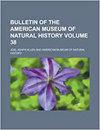Mammalian Diversity and Matses Ethnomammalogy in Amazonian Peru Part 4: Bats
IF 3.4
2区 环境科学与生态学
Q1 BIODIVERSITY CONSERVATION
Bulletin of the American Museum of Natural History
Pub Date : 2021-08-27
DOI:10.1206/0003-0090.451.1.1
引用次数: 1
Abstract
ABSTRACT In this report, the fourth of our monographic series on mammalian diversity and Matses ethnomammalogy in the Yavarí-Ucayali interfluvial region of northeastern Peru, we document the occurrence of 98 species of bats, including 11 emballonurids, 2 noctilionids, 66 phyllostomids, 1 furipterid, 4 thyropterids, 7 vespertilionids, and 7 molossids. New species based on specimens collected in this region (Peropteryx pallidoptera, Micronycteris matses, Hsunycteris dashe, Sturnira giannae, and Thyroptera wynneae) have already been described elsewhere, but noteworthy distributional and taxonomic results newly reported here include the first specimen of Diclidurus isabella from Peru and the diagnosis of Glossophaga bakeri as a species distinct from G. commissarisi. Lists of examined voucher specimens, identification criteria, essential taxonomic references, and summaries of natural history observations are provided for all species. Original natural history information reported herein includes numerous observations of roosting behavior obtained by indigenous Matses collaborators. We assess the Yavarí-Ucayali bat inventory for completeness and conclude that more species remain to be discovered in the region, where as many as 116 species might be expected. Most of the “missing” species (those expected based on geographic criteria but not actually observed) are aerial insectivores, a guild that is notoriously difficult to sample by mistnetting. Of the 98 species in the observed regional fauna, only 71 are known to occur sympatrically at Jenaro Herrera, by far the best-sampled locality between the Yavarí and Ucayali rivers. Faunal comparisons with extralimital inventories (e.g., from Brazil, Ecuador, and French Guiana) suggest that frugivorous bats are substantially more speciose in western Amazonia than in eastern Amazonia, a result that is consistent with previous suggestions of an east-to-west gradient in the trophic structure of Amazonian mammal faunas. As previously reported, the Matses have only a single name for “bat,” but they recognize the existence of many unnamed local species, which they distinguish on the basis of morphology and behavior. However, by contrast with the well-documented accuracy of Matses observations about primates and other game species, recorded Matses monologs about bat natural history contain numerous factual errors and ambiguities. Linguistic underdifferentiation of bat diversity and inaccurate natural history knowledge are both explained by cultural inattention to small, inedible, and inoffensive nocturnal fauna.秘鲁亚马逊地区哺乳动物多样性与交配人种学第4部分:蝙蝠
摘要本报告是我们关于秘鲁东北部Yavarí-Ucayali河间地区哺乳动物多样性和Matses民族哺乳动物谱系的专著系列的第四期,我们记录了98种蝙蝠的发生,包括11种蝙蝠、2种夜蛾、66种叶口蝙蝠、1种毛皮蝙蝠、4种甲状腺蝶、7种蝙蝠和7种莫洛西蝙蝠。基于在该地区采集的标本的新物种(苍白Peropteryx pallidoptera、Micronyteris matses、Hsunyteris dashe、Sturnira giannae和Thyroptera wynneae)已经在其他地方被描述,但这里新报道的值得注意的分布和分类学结果包括来自秘鲁的第一个褐双龙标本,以及将面包舌龙诊断为不同于政委的物种。提供了所有物种的检查凭证标本清单、鉴定标准、重要分类参考文献和自然史观察总结。本文报道的原始自然史信息包括土著Matses合作者获得的大量栖息行为观察结果。我们评估了Yavarí-Ucayali蝙蝠种群的完整性,并得出结论,该地区仍有更多物种有待发现,预计将有多达116种蝙蝠。大多数“失踪”物种(根据地理标准预期但未实际观察到的物种)都是空中食虫动物,这是一个众所周知的难以通过雾网采样的群体。在观察到的区域动物群中的98个物种中,已知只有71个出现在耶纳罗埃雷拉,这是迄今为止雅瓦利河和乌卡亚利河之间采样最好的地区。与超限制种群(例如,来自巴西、厄瓜多尔和法属圭亚那)的区系比较表明,食草蝙蝠在亚马逊西部的物种数量远多于亚马逊东部,这一结果与之前关于亚马逊哺乳动物区系营养结构从东到西梯度的建议一致。正如之前报道的那样,Matses只有一个“蝙蝠”的名字,但他们承认存在许多未命名的当地物种,他们根据形态和行为来区分这些物种。然而,与Matses对灵长类动物和其他猎物物种的观察结果的准确性形成鲜明对比的是,有记录的Matses关于蝙蝠自然史的单篇文章包含了许多事实错误和歧义。蝙蝠多样性的语言差异不足和自然史知识的不准确都是由于文化对小型、不可食用和无害的夜间动物群的忽视。
本文章由计算机程序翻译,如有差异,请以英文原文为准。
求助全文
约1分钟内获得全文
求助全文
来源期刊
CiteScore
7.90
自引率
2.90%
发文量
4
审稿时长
>18 weeks
期刊介绍:
The Bulletin, published continuously since 1881, consists of longer monographic volumes in the field of natural sciences relating to zoology, paleontology, and geology. Current numbers are published at irregular intervals. The Bulletin was originally a place to publish short papers, while longer works appeared in the Memoirs. However, in the 1920s, the Memoirs ceased and the Bulletin series began publishing longer papers. A new series, the Novitates, published short papers describing new forms.

 求助内容:
求助内容: 应助结果提醒方式:
应助结果提醒方式:


